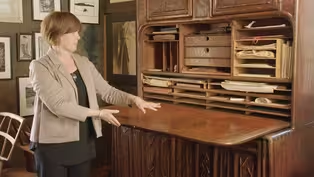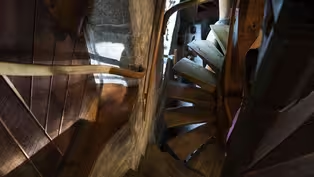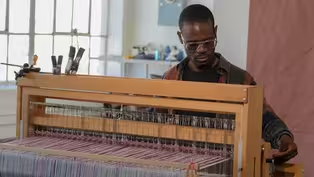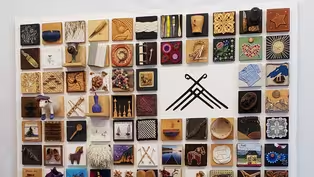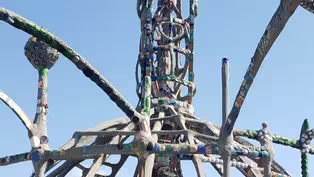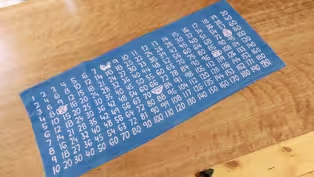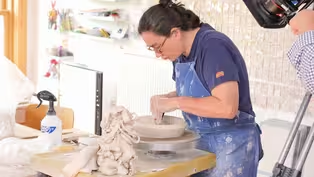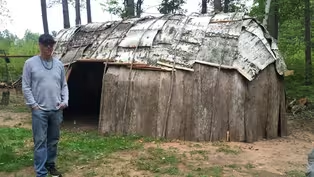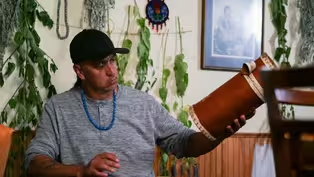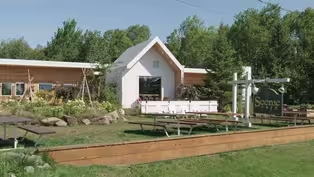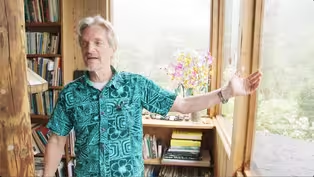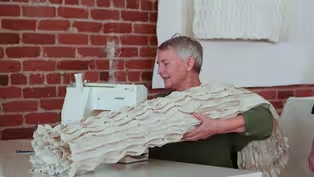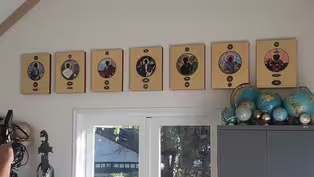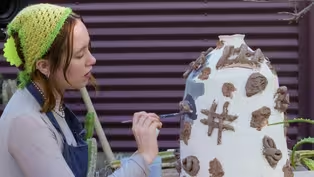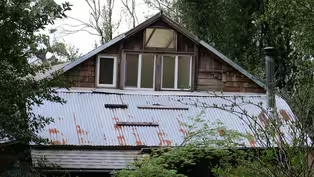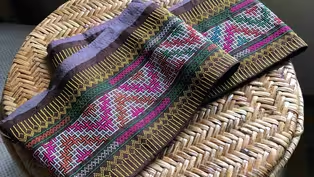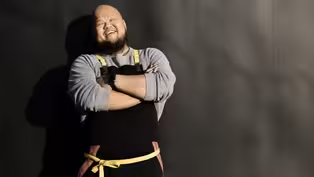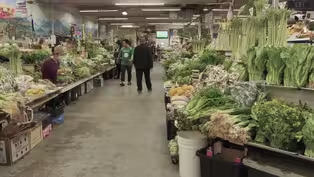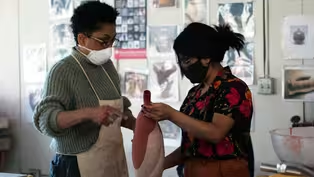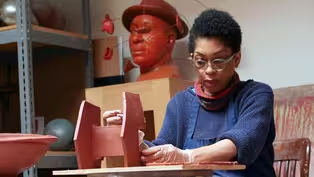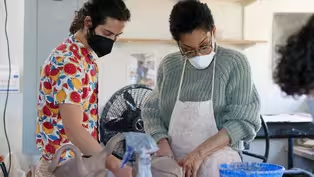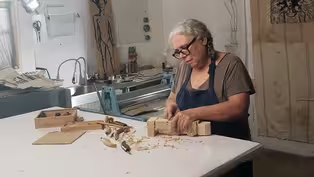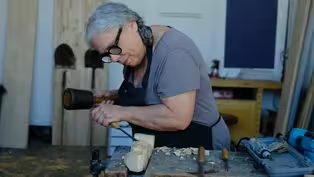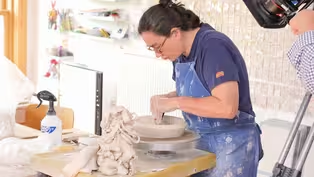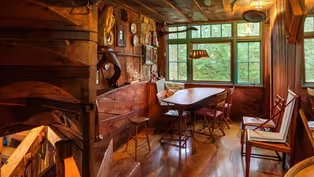
Ojibwe artist Biskakone Greg Johnson
Clip: Season 14 | 9m 47sVideo has Closed Captions
Ojibwe artist Biskakone Greg Johnson featured in the HOME episode
Greg Johnson is an Ojibwe tribal member, cultural practitioner, and educator committed to learning and teaching the traditional methods and crafts of the Ojibwe people. He has mastered the crafts of cedar bark mat weaving, beadwork, weaving winnowing baskets, and winter bark basket making, moccasin sewing, and canoe building. Segment from the HOME episode
Problems playing video? | Closed Captioning Feedback
Problems playing video? | Closed Captioning Feedback

Ojibwe artist Biskakone Greg Johnson
Clip: Season 14 | 9m 47sVideo has Closed Captions
Greg Johnson is an Ojibwe tribal member, cultural practitioner, and educator committed to learning and teaching the traditional methods and crafts of the Ojibwe people. He has mastered the crafts of cedar bark mat weaving, beadwork, weaving winnowing baskets, and winter bark basket making, moccasin sewing, and canoe building. Segment from the HOME episode
Problems playing video? | Closed Captioning Feedback
How to Watch Craft in America
Craft in America is available to stream on pbs.org and the free PBS App, available on iPhone, Apple TV, Android TV, Android smartphones, Amazon Fire TV, Amazon Fire Tablet, Roku, Samsung Smart TV, and Vizio.
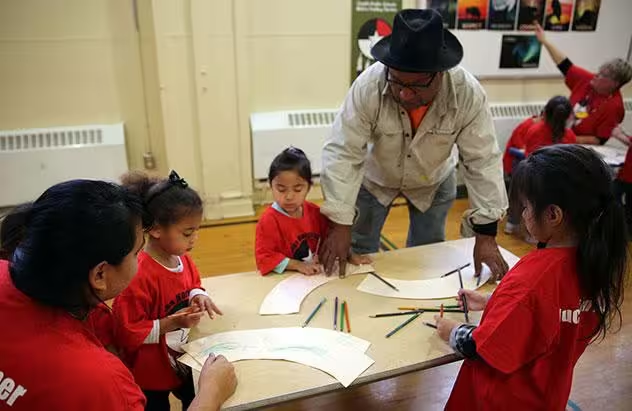
Education Guides
Download Craft in America education guides that educate, involve, and inform students about how craft plays a role in their lives, with connections to American history and culture, philosophies and science, social causes and social action.Providing Support for PBS.org
Learn Moreabout PBS online sponsorship(gentle music) - Home is where we harvest our fish.
Home is where we knock the rice.
Home is out there in the canoes.
Home is when we're out there with our families and we're picking those berries, getting scratched up in the thorns.
You know, that's home.
Home is also above the clouds, where our ancestors go, into the stars, into the Northern Lights.
That's our other home, where we come from and where we go in the end.
Home is where we raise our children, and home is where we make our life with our partner.
All of those things, you know, that means home is a huge range.
You know, it's a huge range.
And within it, we can find all the things that'll give us a good life.
Every Ojibwe settlement within Michigan, Minnesota, and Wisconsin, there's an abundance of wild rice.
For the Ojibwe people, that's what we know as manoomin.
We have a storm that's gonna roll in here, and this abrasor here, it's gonna come off, it's gonna fall back in the water.
We bind this rice, anything that hits it, the rice will not come off.
And it allows the rice to ripen.
And later we come back, we untie it and we slap it, and 100% ripe rice comes out.
So it's not lost back to the elements or the animals.
There's nothing that can get this rice right now.
The state of Wisconsin outlawed this form of rice bundlings.
It's illegal to do it, but me as a cultural practitioner and a teacher, and educator, and father, hunter gatherer, I have the right to do this.
I have the authority from the Great Spirit and my ancestors to do this.
We have to continue this type of thing on because without this knowledge, we're just descended from people who used to call themselves Ojibwe.
(gentle music) Growing up, I would go into these museums and I would see these amazing items.
I wanted to know how to make all the crafts, all the Ojibwe things.
I wanted to know how to make some moccasins, and I wanted to know how to make a canoe, and I wanted to learn how to rice.
I wanted to be a good hunter and a provider for my family.
And it takes a lifetime to know something.
And so I spent a good majority of my life seeking that knowledge.
There's regular manoomin, which is brown or black, but then we have natagame manoomin.
The rice is just harvested freshly off the lake, it's still green and you only have a small window to make that.
These two elders, Grace and Delia Artishan, they were talking about bead work.
So I just sat there and closed my eyes and I imagined everything they were talking about.
Grace was saying she puts the needle, with a thread on through, she strings it up, pulls it all the way up and she puts on four beads, and then she puts the needle back through the material and comes back through the last two and puts on four more.
And that's all I had to hear.
I took that and then I went home that night and I tried it and tried it, tried it until I figured it out.
(gentle music) And if nobody was around to teach me then I taught myself how to do it, and it went on from there.
What my daughter, Wasanodae, is doing here, she's dancing on the rice.
She's just rubbing her feet along the rice hull and what it's gonna do is gonna roll that jacket off.
I went to our museum and I would look at the moccasins, they were called the split-toe moccasins, and so I said I want to be the one who revives these.
She's using just a little bit of her weight and she can feel that under her foot.
That's one of the important roles of the moccasins.
We make for beauty and for purpose.
After probably about 40 pairs, I finally figured it out.
Now I teach classes on moccasin making, and I share my knowledge.
I might have figured it out after it was gone for a while, but I don't own it, the people own it, so, I give that back to our communities whenever I can, you know.
- A lot of the traditional ways were lost, so, we really rely on those who are bringing back crafts and arts where maybe we only have old journal entries, or illustrations, or really old photographs of, of these arts being practiced.
To start etching on the winter bark you need to first scribe a pattern in there with an awl, and then you're really just working with negative space, so you're removing the layer of bark that has tannins to expose the summer bark underneath.
These winter bark baskets would be used for gathering baskets, and sugar containers, and all sorts of things for everyday life.
- Florals that we usually have depicted on some of our items are representation of the natural world.
We have tobacco leaves, we have five petal flowers, four petal flowers, sometimes you'll see a squash blossom.
There's insects, dragonflies, butterflies, and maybe you'll even see some rabbits or blue jays, you know, once in a while.
- Many tribes, they've been really heavily affected by assimilation and intergenerational trauma, a lot of knowledge has been lost.
The aim was to strip our people from our traditional ways.
How I see it, is that every day where we are living our Anishnaabe culture is a radical act of resistance against those that would strip us from who we are.
(bright music) - These nooshkaachinaagan, these winnowing baskets, are made so we can throw it up in the air, and the chaff will blow away and the rice will come back down.
Traditionally, the parching, and the dancing, and the winnowing was all done right near the rice bed, and then they would fill their birch bark baskets up with the finished rice.
Birch bark is our most utilized possession in our culture.
This is a gift, to us, from creation.
What I'm looking for when I harvest it is something that's kind of pliable, something that's not too thin.
The thickness of the bark right here, we call basket bark.
Anything thicker than that is what we use in our wiigwaasi-jiimaan, or birch bar canoes.
If you get something thinner, it's called Mazinibaganjigan wiigwaas, which is almost like paper, paper bark.
So now we have a mechanized form of preparing manoomin, and if our ancestors had that technology a hundred years ago, they'd be using it, just like we are today.
And so we are our ancestors.
Everything they do, we still do it today.
And whatever method that we use today, they would do the same thing, long ago.
And you're gonna go around both of these, right here.
- Okay.
We're making a traditional cedar mat.
- This idea spawned from looking at old photos of our people long ago sitting on these mats and using them.
And what we've come to know recently is that cedar is antibacterial.
When the people dried their foods on there long ago, it helped aiding in the preserving process.
Up through and down.
- My dad's always doing something new and feels like we're reviving something every day.
For a long time I didn't really appreciate it.
It was just my life, but seeing how other people lived versus being immersed in my culture, it feels bigger than me.
My dad always says I'm carrying two bundles, or I have the best of both worlds.
I get to walk both paths.
- Perfect.
Look at that.
- You have a tie to the place of your ancestors and the place where your love is, where your family is, that's where your home is.
Home has nothing to do with the house.
I love the house, but wherever the manoomin is and wherever the birch trees are, that's home and we'll have everything that we need.
- This lodge is what we call, in Ojibwe language, is waginogan.
That structure housed our people long ago, and that kept our people safe, it kept them out the elements, and it gave them a place.
Our culture will house us through our ability and knowledge to make those wigwams and lodges.
Our culture will feed us through our treaty rights.
We have our religions to keep us sane, and and to keep us focused.
We also have our crafts to give us therapy and keep us focused as well.
So culture's very much alive and thriving here in Lac du Flambeau.
We're breathing it and living it every day.
(bright music)
Wharton Esherick's Standing Desk
Video has Closed Captions
Clip: S14 | 1m 41s | Wharton Esherick Museum's Executive Director, Julie Signlin on Esherick's standing desk (1m 41s)
Wharton Esherick's Bedroom Trap Door and Desk
Video has Closed Captions
Clip: S14 | 1m 41s | Wharton Esherick's Bedroom Trap Door and Desk. Bonus video from HOME episode (1m 41s)
Weaver Diedrick Brackens on his Baby Blanket series
Video has Closed Captions
Clip: S14 | 1m 13s | Weaver Diedrick Brackens on his Baby Blanket series. Bonus video from INSPIRATION episode (1m 13s)
Video has Closed Captions
Clip: S14 | 10m 53s | Weaver Diedrick Brackens featured in the INSPIRATION episode (10m 53s)
Video has Closed Captions
Clip: S14 | 1m 44s | Executive Director of North House Folk School, Greg Wright on the Wall of Craft (1m 44s)
Rogelio Acevedo on Watts Towers Arts Center
Video has Closed Captions
Clip: S14 | 1m 35s | Education Coordinator Rogelio Acevedo on the Watts Towers Art Center Campus (1m 35s)
Video has Closed Captions
Clip: S14 | 1m 30s | Potter Ayumi Horie on the tenegui she designed. Bonus video from the INSPIRATION episode. (1m 30s)
Potter Ayumi Horie on her murals
Video has Closed Captions
Clip: S14 | 36s | Potter Ayumi Horie on making her home a space for learning using murals (36s)
Potter Ayumi Horie on her color study tiles
Video has Closed Captions
Clip: S14 | 1m 51s | Potter Ayumi Horie on her color study tiles. Bonus video from INSPIRATION episode (1m 51s)
Video has Closed Captions
Clip: S14 | 7m 56s | Potter Ayumi Horie from the INSPIRATION episode (7m 56s)
Ojibwe artist Biskakone Greg Johnson on the waganogan
Video has Closed Captions
Clip: S14 | 1m 32s | Ojibwe artist Biskakone Greg Johnson on the waganogan. Bonus video from HOME episode (1m 32s)
Ojibwe artist Biskakone Greg Johnson
Video has Closed Captions
Clip: S14 | 9m 47s | Ojibwe artist Biskakone Greg Johnson featured in the HOME episode (9m 47s)
New Scenic Cafe's Timber Frame
Video has Closed Captions
Clip: S14 | 1m 7s | New Scenic Cafe manager Eric Sturtz on their timber frame structure built by Gerald David (1m 7s)
Micah Van der Ryn on repurposed materials
Video has Closed Captions
Clip: S14 | 57s | Micah Van der Ryn on the repurposed materials used in the house built by his father (57s)
Video has Closed Captions
Clip: S14 | 58s | Artist Mary Little on the repetitive nature of her textile work (58s)
Mark Steven Greenfield on his work
Video has Closed Captions
Clip: S14 | 3m 58s | Artist Mark Steven Greenfield on his work. Bonus video from the INSPIRATION episode (3m 58s)
Maddy Leeser on her Memory Jugs
Video has Closed Captions
Clip: S14 | 2m 1s | Ceramic artist Maddy Leeser on her Memory Jug series (2m 1s)
Jim Campe on the Outlaw Builder's structures
Video has Closed Captions
Clip: S14 | 1m 56s | Jim Campe on the Outlaw Builder's structures. Bonus video from the HOME episode. (1m 56s)
Video has Closed Captions
Clip: S14 | 10m 31s | Hmong Paj Ntaub embroidery segment from the INSPIRATION episode (10m 31s)
Chef Yia Vang on what it means to be Hmong
Video has Closed Captions
Clip: S14 | 1m 21s | Chef Yia Vang on what it means to be Hmong. Bonus video from the INSPIRATION episode. (1m 21s)
Chef Yia Vang on Hmong Village
Video has Closed Captions
Clip: S14 | 1m 20s | Chef Yia Vang on Hmong Village. Bonus video from the INSPIRATION episode. (1m 20s)
Ceramic artist Syd Carpenter on working with her students
Video has Closed Captions
Clip: S14 | 1m 2s | Ceramic artist Syd Carpenter on how she works with her students at Swarthmore College (1m 2s)
Ceramic artist Syd Carpenter on her Mother Pins series
Video has Closed Captions
Clip: S14 | 1m 22s | Ceramic artist Syd Carpenter on her Mother Pins series. Bonus video from the HOME episode. (1m 22s)
Video has Closed Captions
Clip: S14 | 11m 12s | Ceramic artist Syd Carpenter segment from the HOME episode (11m 12s)
Artist Alison Saar on whittling
Video has Closed Captions
Clip: S14 | 1m 3s | Artist Alison Saar on whittling. Bonus video from INSPIRATION episode. (1m 3s)
Alison Saar, Betye Saar, Maddy Leeser
Video has Closed Captions
Clip: S14 | 10m 5s | Meet the Saar family of artists featured in the INSPIRATION episode (10m 5s)
Video has Closed Captions
Preview: S14 Ep1 | 1m 1s | Watch a 1 minute preview of the INSPIRATION episode (1m 1s)
Video has Closed Captions
Preview: S14 Ep2 | 1m | Watch a 1 min preview of HOME visiting artists whose environments are filled with meaning (1m)
Providing Support for PBS.org
Learn Moreabout PBS online sponsorshipSupport for PBS provided by:
